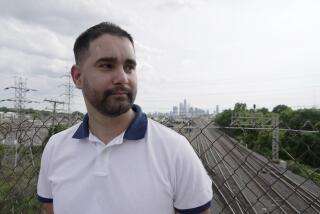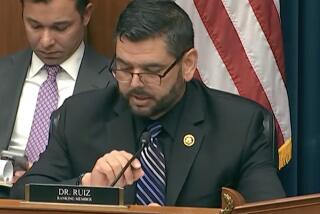Federal AIDS Effort Lags, Called a ‘Mess’ by Critics
- Share via
The much-publicized $100-million federal program to search for AIDS drugs has made little progress in the seven months since it was established and is now beset by criticism from some AIDS researchers and gay activist groups.
When the program was announced in June, top health officials predicted that as many as six experimental drugs would have been tested in as many as 1,000 patients by now. But as of this week, only 133 patients had been enrolled in two tests of the one promising drug, azidothymidine (AZT), at the 19 AIDS treatment evaluation units nationwide. No other drug trials have begun.
“There is very little going on, and what they are doing is peanuts,” said Mathilde Krim, co-chair of the American Foundation for AIDS Research in New York City, citing a “bureaucratic bottleneck” at the National Institute for Allergy and Infectious Diseases (NIAID) in Bethesda, Md., which administers the program. “The whole thing is a mess.”
“They are very slow to get started,” said Jeffrey Levi, executive director of the National Gay and Lesbian Task Force in Washington. “(This) is inexcusable given the nature of the crisis.”
Among the 19 designated centers are County-USC Medical Center, UCLA Medical Center and UC San Diego Medical Center.
The AIDS treatment evaluation units were established at many of the nation’s leading academic medical centers to speed the evaluation of drugs that might prove effective against the AIDS virus. The centers, which also include the UC San Francisco Medical Center and Stanford University, are to receive $700,000 to $2 million each in federal funds annually for five years to pay for the studies.
The drug program’s coordinator downplayed the criticisms, but she and some investigators at the treatment evaluation units acknowledged in interviews this week that the program has been plagued by problems.
They said the obstacles include staff shortages and the limited availability of AZT as well as difficulties in coordinating the activities of leading researchers and in creating a massive organization from scratch.
Drugs yet to be tested include ribavirin, which recently has been shown to have early promise against the AIDS virus in infected individuals who have not yet developed severe symptoms, and dideoxycytidine, a drug that has seemed promising in laboratory tests at the National Cancer Institute.
‘Easy to Be Critical’
“It is easy to be critical, but we have been extremely productive,” said Maureen Myers, the NIAID official who has direct responsibility for the treatment evaluation units. Indeed, Myers said she has been so busy keeping the program operating on a day-to-day basis that she has not had time to hire sufficient staff to ease the work crunch.
The organizational problems appear to be continuing. Last week, the program’s AIDS Clinical Drug Development Committee adjourned its January meeting without discussing four of the eight experimental drugs on the agenda. This key advisory committee reviews laboratory and preliminary clinical results and then decides which drugs merit further tests in patients.
“We have waited three months (since we submitted the data) for them to say something,” said Dr. Arnold Lippa, president of Praxis Pharmaceuticals of Los Angeles, which is developing one of these drugs, AL-721. “We can no longer anticipate any assistance from the federal government and are planning large clinical trials on our own.”
A physician familiar with the committee’s work said that such frustrations are “understandable.”
“There is a backlog of accumulated information about a great number of compounds,” the physician said. “There were earlier committees that apparently did not get the job done.”
The committee reviewed data on AZT, ribavirin, dideoxycytidine and peptide T, sources said. Data on the experimental drugs ampligen, AL-721, immuthiol and a form of biostimulation therapy using electromagnetic fields were not discussed.
Formidable Task
Centralizing the activities of the original 14 treatment evaluation units and an additional five that were funded in the fall has been a formidable task, according to Myers.
After plans for research studies are drafted, for example, they must be discussed and approved by a number of committees, both in Bethesda and at the individual medical centers. This process can delay the start of a study for months, in comparison to research conducted at only one institution.
Moreover, a computerized data-collection system, a key feature of the program, is still not fully operational. One reason is that the $4.4-million contract to coordinate data analysis was awarded--to the Research Triangle Institute in Research Triangle Park, N.C.--only in October, four months after the program was established.
The program represents a major component of Washington’s effort to combat AIDS, which also includes the search for a protective vaccine and educational campaigns to promote “safe sex” practices.
The start-up of drug trials also has been delayed by a decision to focus on AZT instead of other drugs.
Preliminary test results announced by the company last September suggested that AZT may prolong the lives of AIDS patients who have developed the serious lung infection called Pneumocystis carinii pneumonia. Since then, about 3,000 AIDS patients with the pneumonia have been enrolled in an enlarged AZT treatment program coordinated and sponsored by the drug’s manufacturer, Burroughs Welcome Co. of Research Triangle Park.
Drug in Short Supply
But Burroughs Welcome has made only limited quantities of the experimental drug available to the treatment evaluation units, in part because the drug is in short supply. As a result, Myers said that just two AZT studies have started--one in AIDS patients with pneumocystis and the other in patients with Kaposi’s sarcoma.
While additional AZT studies are expected to start soon, “hundreds of hours” have been wasted planning research that may never be done, Myers said.
A Burroughs Welcome official said it is simplistic for the treatment evaluation units to expect automatic priority for AZT research.
“There are studies we can, quite frankly, do faster,” said Dr. Dannie King, the company’s project director for AZT. About 10 other AZT studies are in progress, including major tests through the Veterans Administration, and in Canada, the United Kingdom and Western Europe, King said.
The AIDS virus causes acquired immune deficiency syndrome, a deadly disease that destroys the body’s immune system. As of Monday, 29,582 Americans had contracted AIDS and 16,847 had died. In addition to the 3,000 AIDS patients receiving AZT, about 2,000 are being treated with a variety of experimental drugs, according to the American Foundation for AIDS Research.
More to Read
Sign up for Essential California
The most important California stories and recommendations in your inbox every morning.
You may occasionally receive promotional content from the Los Angeles Times.










